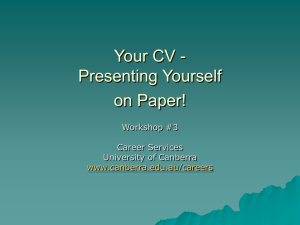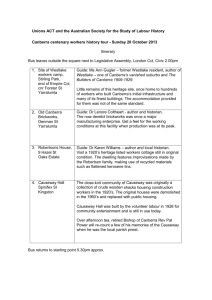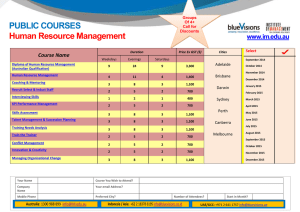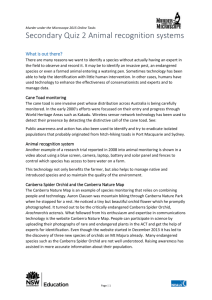an abridged guide to referencing
advertisement
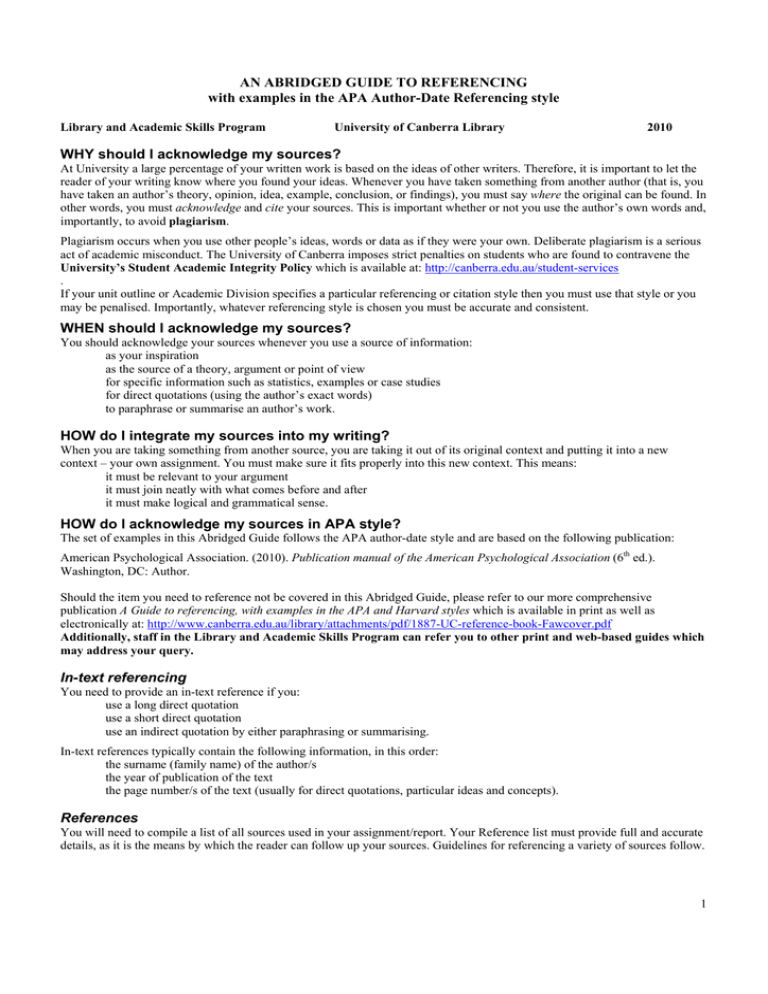
AN ABRIDGED GUIDE TO REFERENCING with examples in the APA Author-Date Referencing style Library and Academic Skills Program University of Canberra Library 2010 WHY should I acknowledge my sources? At University a large percentage of your written work is based on the ideas of other writers. Therefore, it is important to let the reader of your writing know where you found your ideas. Whenever you have taken something from another author (that is, you have taken an author’s theory, opinion, idea, example, conclusion, or findings), you must say where the original can be found. In other words, you must acknowledge and cite your sources. This is important whether or not you use the author’s own words and, importantly, to avoid plagiarism. Plagiarism occurs when you use other people’s ideas, words or data as if they were your own. Deliberate plagiarism is a serious act of academic misconduct. The University of Canberra imposes strict penalties on students who are found to contravene the University’s Student Academic Integrity Policy which is available at: http://canberra.edu.au/student-services . If your unit outline or Academic Division specifies a particular referencing or citation style then you must use that style or you may be penalised. Importantly, whatever referencing style is chosen you must be accurate and consistent. WHEN should I acknowledge my sources? You should acknowledge your sources whenever you use a source of information: as your inspiration as the source of a theory, argument or point of view for specific information such as statistics, examples or case studies for direct quotations (using the author’s exact words) to paraphrase or summarise an author’s work. HOW do I integrate my sources into my writing? When you are taking something from another source, you are taking it out of its original context and putting it into a new context – your own assignment. You must make sure it fits properly into this new context. This means: it must be relevant to your argument it must join neatly with what comes before and after it must make logical and grammatical sense. HOW do I acknowledge my sources in APA style? The set of examples in this Abridged Guide follows the APA author-date style and are based on the following publication: American Psychological Association. (2010). Publication manual of the American Psychological Association (6th ed.). Washington, DC: Author. Should the item you need to reference not be covered in this Abridged Guide, please refer to our more comprehensive publication A Guide to referencing, with examples in the APA and Harvard styles which is available in print as well as electronically at: http://www.canberra.edu.au/library/attachments/pdf/1887-UC-reference-book-Fawcover.pdf Additionally, staff in the Library and Academic Skills Program can refer you to other print and web-based guides which may address your query. In-text referencing You need to provide an in-text reference if you: use a long direct quotation use a short direct quotation use an indirect quotation by either paraphrasing or summarising. In-text references typically contain the following information, in this order: the surname (family name) of the author/s the year of publication of the text the page number/s of the text (usually for direct quotations, particular ideas and concepts). References You will need to compile a list of all sources used in your assignment/report. Your Reference list must provide full and accurate details, as it is the means by which the reader can follow up your sources. Guidelines for referencing a variety of sources follow. 1 American Psychological Association (APA) referencing style based on: American Psychological Association. (2010). Publication manual of the American Psychological Association (6th ed.). Washington, DC: Author. More information is available from: http://www.apastyle.org/apa-style-help.aspx BOOKS One author Two authors Three to five authors For the first in-text reference, list all the authors’ family names. Use et al. for subsequent entries. Editor No author or editor - Cite the title in the position of ‘author’. - The title may be shortened to the main title (omitting the sub-title) or the first few words of the title. Chapter in edited book Corporate author when the author is also the publisher Citing a source within a source When citing a source you haven’t read yourself, but which is referred to in a source you have read. In-text reference Reference list. ‘Information prominent’ (the author’s name is within parentheses): The conclusion reached in a recent study (Cochrane, 2007) was that… Cochrane, A. (2007). Understanding urban policy: A critical approach. Malden, MA: Blackwell Publishing OR ‘Author prominent’ (the author’s name is outside the parentheses): Cochrane (2007) concluded that… Context and communication were considered (Littlejohn & Foss, 2005)… OR Littlejohn and Foss (2005) maintained... Writing in biomedical sciences requires close attention to an acceptable style (Duffy, Deakin, Wieniawa-Narkiewicz, & Wilson, 2001) and it is… Subsequent in-text reference/s: (Duffy et al., 2001) In discussing best practice, Zairi (1999) identified… Littlejohn, S. W., & Foss, K. A. (2005). Theories of human communication (8th ed.).Southbank, Australia: Thomas Wadsworth. Duffy, A., Deakin, V., Wieniawa-Narkiewicz, E., & Wilson, K. (2001). Guide to writing in biomedical sciences. Australia: University of Canberra. Zairi, M. (Ed.). (1999). Best practice: Process innovation management. Oxford, England: Butterworth-Heinemann. Macroeconomics considers prices and quantities (Macroeconomics, prices and quantities, 1983, pp. 4357), so it is important to… Macroeconomics, prices and quantities: Essays in memory of Arthur M. Okun. (1983). Oxford, England: Blackwell. A discussion about Australia’s place in today’s world (Richards, 1997) included reference to… A recent study (Australian Institute of Health and Welfare [AIHW], 2009)… Subsequent in-text reference/s: The AIHW (2009) found that… Lilly (as cited in Maxwell, 1999, p. 25) stated that “. . . “. Richards, K. C. (1997). Views on globalization. In H. L. Vivaldi (Ed.), Australia in a global world. North Ryde, Australia: Century. Australian Institute of Health and Welfare. (2009). Indigenous housing needs 2009: A multi-measure needs model (AIHW cat. no. HOU 214). Canberra, Australia: Author. Maxwell, F. (1999). Phonology. San Francisco, CA: Brooks Cole. JOURNAL & NEWSPAPER ARTICLES Journal article with one author separated paging Each issue begins on page one. In an earlier article, it was proposed (Jackson, 2007)… Jackson, A. (2007). New approaches to drug therapy. Psychology Today and Tomorrow, 27(1), 54-59. 2 Article in online journal with six or seven authors Give the first author’s family name followed by ‘et al.’ for all in-text references. Journal article retrieved from a database - with a DOI (digital object identifier) Journal article retrieved from a database - without a DOI Give the URL of the journal’s home page instead of the database name. Newspaper article – with an author Newspaper article – without an author Newspaper article retrieved from a database Give the URL of the newspaper’s home page. A simple ALMA is described in a recent study (Restouin et al., 2009). A study examining priming (Johns & Mewhort, 2009) discovered … Restouin, A., Aresta, S., Prébet, T., Borg, J., Badache, A., & Collette, Y. (2009). A simplified, 96-well–adapted, ATP luminescence–based motility assay. BioTechniques, 47, 871–875. Retrieved from http://www.biotechniques.com/BiotechniquesJournal/ Note: Use a DOI (digital object identifier) if one is assigned instead of the “Retrieved from’ statement and URL. Johns, E., & Mewhort, D. (2009). Test sequence priming in recognition memory. Journal of Experimental Psychology: Learning, Memory and Cognition, 35, 1162-1174. doi: 10.1037/a0016372 The effects of climate change on agriculture are studied by Ramalho, Da Silva and Dias (2009)… Ramalho, M., Da Silva, G., & Dias, L. (2009). Genetic plant improvement and climate changes. Crop Breeding and Applied Biotechnology, 9(2), 189-195. Retrieved from http://www.sbmp.org.br/cbab The notion of a Bill of Rights may be inappropriate in the Australian context (Waterford, 2007). The redesign of the internet (“Internet pioneer”, 2007)… Waterford, J. (2007, May 30). Bill of Rights gets it wrong. The Canberra Times, p. 11 In an attempt to save the tiger, Darby (2002) provided… Internet pioneer to oversee network redesign. (2007, May 28). The Canberra Times, p. 15. Darby, A. (2002, August 20). Rarest tiger skin a rugged survivor. Sydney Morning Herald. Retrieved from http://www.smh.com.au ONLINE LECTURE/TUTORIAL NOTES & E-RESERVE ITEMS Lecture / tutorial notes - online In examining the genre of fiction (St. Vincent Welch, 2009)… Item from EReserve In a review of the Freedom of Information Act 1988, Rose (1996, p. 4) determined that… St. Vincent Welch, S. (2009). Unit 8147 Writing short narratives, lecture 1, week 1: What is fiction? [Lecture PowerPoint slides]. Retrieved from http://learnonline.canberra.edu.au Rose, A. (1996, September). Freedom of information under review. Canberra Bulletin of Public Administration, 80, 4-8. Retrieved from University of Canberra E-Reserve. OTHER SOURCES DVD / Videorecording Jane Austen’s world came alive in Sense and sensibility (Lee, 1995). Lee, A. (Director). (1995). Sense and sensibility [DVD]. Australia: Columbia TriStar Home Video. Figure, Table, Graph, Map or Chart The internal processes were well described (Kaplan & Norton, 2004), which led to… Image - online The effective use of light in Monet’s ‘Haystacks’ (Monet, 1890)… Web document dated & author or sponsor given An RBA paper (Simon, Smith, & West, 2009) found that participation in a loyalty program and access to an interest-free period… Web source with no page numbers Give a paragraph number. (use the abbreviation “para.”) or a section heading & paragraph no. Copyright ownership of “lecture notes created as part of a lecturer's employment at the university” (University of Canberra, 2009, “University material”, para. 2)… Kaplan, R. S., & Norton, D.P. (2004). Internal processes deliver value over different time horizons. [Graph]. In Strategy maps: Converting intangible assets into tangible outcomes (p. 48). Boston, MA: Harvard Business School. Monet, C. (1890). Haystacks, midday [Painting]. National Gallery of Australia, Canberra. Retrieved from http://artsearch.nga.gov.au/DetailLRG.cfm?IRN=29073&View=LRG Simon, J., Smith, K., & West, T. (2009). Price incentives and consumer payment behaviour (RBA Research discussion paper). Retrieved from the Reserve Bank of Australia website: http://www.rba.gov.au/PublicationsAndResearch/RDP/RDP 2009-04.html University of Canberra. (2009). Copyright guide. [Version 13 – 2 January]. Retrieved from http://www.canberra.edu.au/copyright/guide#heading14 3 The examples provided for the American Psychological Association (APA) referencing style would look like the following entries in a Reference list References Note: APA requires that the Reference List be double spaced and that entries have a hanging indent. Australian Institute of Health and Welfare. (2009). Indigenous housing needs 2009: A multi-measure needs model (AIHW cat. no. HOU 214). Canberra, Australia: Author. Cochrane, A. (2007). Understanding urban policy: A critical approach. Malden, MA: Blackwell Publishing. Darby, A. (2002, August 20). Rarest tiger skin a rugged survivor. Sydney Morning Herald. Retrieved from http://www.smh.com.au Duffy, A., Deakin, V., Wieniawa-Narkiewicz, E., & Wilson, K. (2001). Guide to writing in biomedical sciences. Australia: University of Canberra. Internet pioneer to oversee network redesign. (2007, May 28). The Canberra Times, p. 15. Jackson, A. (2007). New approaches to drug therapy. Psychology Today and Tomorrow, 27(1), 54-59. Johns, E., & Mewhort, D. (2009). Test sequence priming in recognition memory. Journal of Experimental Psychology: Learning, Memory and Cognition, 35, 1162-1174. doi: 10.1037/a0016372 Kaplan, R. S., & Norton, D. P. (2004). Internal processes deliver value over different time horizons. [Graph]. In Strategy maps: Converting intangible assets into tangible outcomes (p. 48). Boston, MA: Harvard Business School. Lee, A. (Director). (1995). Sense and sensibility [DVD]. Australia: Columbia TriStar Home Video. Littlejohn, S. W., & Foss, K. A. (2005). Theories of human communication (8th ed.).Southbank, Australia: Thomas Wadsworth. Macroeconomics, prices and quantities: Essays in memory of Arthur M. Okun. (1983). Oxford, England: Blackwell. Maxwell, F. (1999). Phonology. San Francisco, CA: Brooks Cole. Monet, C. (1890). Haystacks, midday [Painting]. National Gallery of Australia, Canberra. Retrieved from http://artsearch.nga.gov.au /Detail-LRG.cfm?IRN=29073&View=LRG Ramalho, M., Da Silva, G., & Dias, L. (2009). Genetic plant improvement and climate changes. Crop Breeding and Applied Biotechnology, 9(2), 189-195. Retrieved from http://www.sbmp.org.br/cbab Restouin, A., Aresta, S., Prébet, T., Borg, J., Badache, A., & Collette, Y. (2009). A simplified, 96-well–adapted, ATP luminescence–based motility assay. BioTechniques, 47, 871–875. Retrieved from http://www.biotechniques.com/BiotechniquesJournal/ Richards, K. C. (1997). Views on globalization. In H. L. Vivaldi (Ed.), Australia in a global world. North Ryde, Australia: Century. Rose, A. (1996, September). Freedom of information under review. Canberra Bulletin of Public Administration, 80, 4-8. Retrieved from University of Canberra E-Reserve. Simon, J., Smith, K., & West, T. (2009). Price incentives and consumer payment behaviour (RBA Research discussion paper). Retrieved from the Reserve Bank of Australia website: http://www.rba.gov.au/PublicationsAndResearch/RDP /RDP2009-04.htmlw.rba.gov.au/PublicationsAndResearch/RDP/RDP2009-04.html St. Vincent Welch, S. (2009). Unit 8147 Writing short narratives, lecture 1, week 1: What is fiction? [Lecture PowerPoint slides]. Retrieved from http://learnonline.canberra.edu.au University of Canberra. (2009). Copyright guide. [Version 13 – 22 January]. Retrieved from http://www.canberra.edu.au/copyright/guide#heading1 Waterford, J. (2007, May 30). Bill of Rights gets it wrong. The Canberra Times, p. 11 Zairi, M. (Ed.). (1999). Best practice: Process innovation management. Oxford, England: Butterworth-Heinemann. If you need more information about referencing, contact: The Library’s Research Desk, – phone 6201 5082 Ask a Librarian (electronic reference service) – askalibrarian@canberra.edu.au Chat with a librarian – http://www.canberra.edu.au/library/refchat Academic Skills Program (ASP) – phone 6201 2205 4
